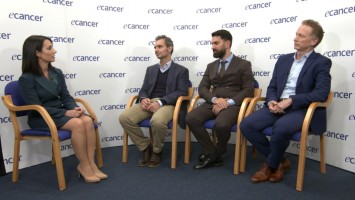Childhood Cancer 2016
A novel biomarker for paediatic tumours
Dr Kathleen Birley - UCL Institute of Child Health, London, UK
My project is to target a protein called B7H3 with different types of immunotherapy. There have been huge improvements with how we treat childhood cancer with significant improvements in mortality and morbidity but there are still lots of high risk cancers that have a really quite poor prognosis and our current treatment modalities have a lot of side effects, there are a lot of problems with late effects and secondary malignancies in our childhood cancer survivors. So there’s a real need to look for new and exciting treatments and immunotherapy is an area that is growing, there have been some really great developments over the last couple of years. So it’s one potential area where you can look for new treatments which are very targeted and very powerful and with potentially very long-lasting effects.
So B7H3 there’s increasing interest in targeting for three main reasons, one of which is its expression pattern. It’s very highly expressed in a range of different cancers including some relatively common childhood cancers like neuroblastoma and DIPG as well as some of the much rarer childhood cancers and in lots of adult cancers as well. It’s relatively poorly expressed on healthy tissues in the body which gives it a very high therapeutic index which makes it a good target for immunotherapy.
The other two interesting things about B7H3, one of which is as a member of the B7 family it almost certainly has a role in immunomodulation and there’s increasing evidence to suggest that it’s involved in immuno-inhibition, both for the innate and the adaptive immune system. So particularly T-cells it seems to inhibit within the tumour microenvironment so targeting it you have a potential option for an immune checkpoint which would obviously increase the body’s own response to the cancer.
The third interesting thing about B7H3 is that it seems to have a role in oncogenesis. So again the pathways aren’t fully understood and are still being explored but cancers with high levels of B7H3 are more aggressive, they tend to be more invasive, they tend to metastasise more. So, again, in theory by targeting B7H3 you can reduce some of that oncogenic process. So three reasons to look for it.
What is the grant enabling you to do?
The lab that I’m working at already has a phage display library against B7H3 so the first part of my project is going to be to pan that library and try and get single chain variable fragments with an affinity for B7H3. I’m hoping to get about twenty single chain variable fragments with different levels of affinity and from there you can do quite a lot. The first thing I’m going to do is make some antibodies and see if they have any effect on complement dependent cytotoxicity and cell mediated dependent cytotoxicity with neuroblastoma cells in vitro. I’m also hoping to transduce my single chain variable fragments into CAR T-cells and again see if I can get any CAR mediated cell mediated cytotoxicity against neuroblastoma cells in vitro.
I’m also hoping just to create simple binders using my single chain variable fragments and see whether they affect the activity of T-cells in culture with neuroblastoma cells to see if there is any influence on that immune inhibition that we were talking about. Then potentially down the line there’s potential to look at this oncogenic process as well that’s probably going to be falling out of the scope of my project.
What’s the ultimate aim for how this impacts children with cancer?
Successful targeting of B7H3 could lead to new therapies for childhood cancer and one of the things I really like about the project is because of its expression pattern it’s not limited to a single kind of cancer. So my main model is neuroblastoma but you could extract the data to DIPG and also to the rarer cancers that don’t get a lot of funding for new research, things like desmoplastic small round cell tumour also has high levels of B7H3 expression. So it’s got a wide variety of cancers it could potentially be therapeutic for and because of its potential to reduce its immune inhibition, to reduce the oncogenic processes, it could also be a really great adjunct to our current cancer treatments for lots of these kinds of cancers.








